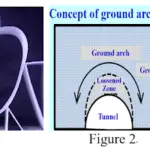When it comes to estimating and testing the strength of materials, people sometimes gets confused between toughness and strength so here is answer to the difference between compressive toughness and flexural toughness.
Before understanding the compression and tension \”term\” you \”must\” know what is toughness and strength.
First, I would like to clarify that toughness is different from strength. Two materials can be of same strength but different toughness.
Now to define strength we can state :-
Strength is the ultimate load at which the Material will fail so concrete having a compressive strength of 3000 psi means that it can sustain a compressive stress of 3000 psi after which it cracks and fails.
Now coming to toughness,
it the ability of material to absorb energy and elastically deform without rupturing or fracturing. It is actually the amount of energy per unit volume that a material can absorb. Toughness requires a balance between strength and ductility.
So basically the area under the stress-strain curve gives the toughness of a material. See the following graph:

A material able to undergo plastic deformation will be tougher than a brittle material.
This graph shows stress-strain curves of three types of concretes.
One is plain concrete and the two others are fibre reinforced concretes with 2% and 3% fibre content.
Now the strength of all the three concretes is almost the same i.e. around 40MPa at which all the concrete specimens crack.
However, the toughness of Fibre reinforced concrete specimens is much higher than plain concrete.
Plain concrete fails in a brittle manner with no plastic deformation, while fibre reinforced concrete fails in a elasto-plastic manner.
So even after initial cracks develop, it is able to take load until final failure.
This is evident from the area under the Stress-Strain curve. Evident from the graph is also that 3% fibre concrete has more toughness than 2% fibre concrete.
This is with regards to compressive toughness.
A similar stress strain curve for tensile loading (split cylinder test, modulus of rupture test, or direct tension test) will give the tensile toughness of concrete.
Needless to say, concrete is very weak in tension and without any reinforcement; it would not display any meaningful tensile toughness.
So from above discussion we can conclude that :-
As the name suggested Compressive toughness is the ability to withstand compression . In most of the codes a relation between compressive and flexural strength has been established.
So most often in construction sites we only perform compression test to ensure that the concrete used has adequate strength.
One of the main factors that interests structure Engineers is the pattern in which it cracks. Concrete is very strong in compression when compared to flexural strength. The compressive strength may be found out using compression test.
Flexural strength of concrete as per IS 456 is
Like Us on Facebook!
Flexural strength fct = 0.7 square root (fck) N/mm2
Subscribe Us on YouTube!
Flexural strength is found out using beam bending test in which we may or may not provide reinforcement.
Concrete has high strength in compression.
Often it is designed to have 5,000 or 6,000 psi, sometimes even more.
In either tension or flexing concrete tends to not have much strength. Of course we compensate for that weakness by strategically placing steel rebar so it will preform as needed.
Steel on the other hand will easily handle 20,000 psi in either compression or tension.












